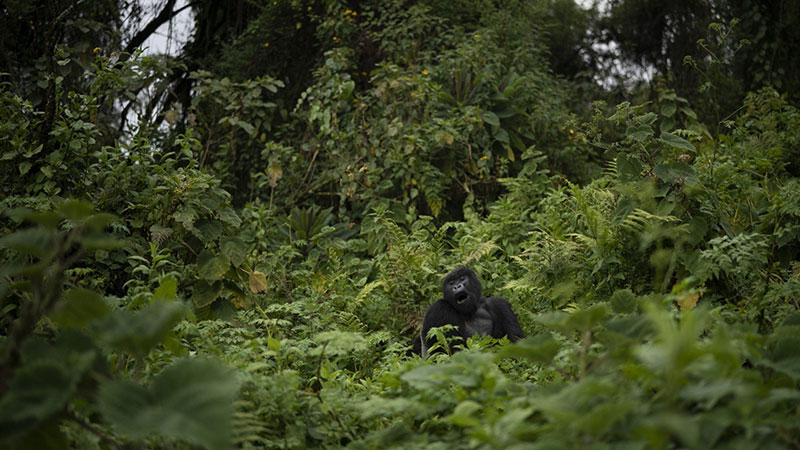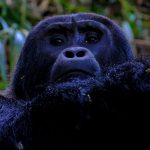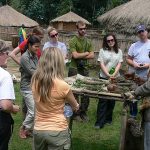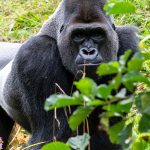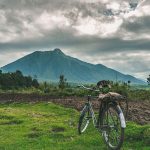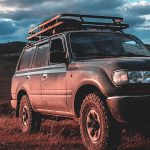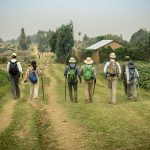The most famous and hot spot destination in Rwanda, Volcanoes National Park (French: Parc National des Volcans Kinyarwanda: Pariki y’Igihugu y’Ibirunga) lies in northwestern Rwanda and borders Virunga National Park in the Democratic Republic of Congo and Mgahinga Gorilla National Park in Uganda. The national park is known as a haven for the rare and endangered mountain gorilla and golden monkeys. It is home to five of the eight volcanoes of the Virunga Mountains (Karisimbi, Bisoke, Muhabura, Gahinga and Sabyinyo), and spans 160 km2 covered in rainforest and bamboo.
“In the heart of Central Africa, so high up that you shiver more than you sweat,” wrote the eminent primatologist Dian Fossey, “are great, old volcanoes towering almost 15,000 feet, and nearly covered with rich, green rainforest – the Virungas”.
Volcanoes National Park is named after the chain of dormant volcanoes making up the Virunga Massif: Karisimbi (the highest at 4,507m), Bisoke with its verdant Crater Lake, Sabinyo, Gahinga and Muhabura. These five volcanoes have become a hiking paradise for the mountain hikers and photographers who like to take land scape photography.
Gorillas, of course, pay no heed to borders and are known to cross between the countries, although most habituated groups are to be found in Volcanoes National Park. The massif is home to around half of the world’s precious mountain gorillas – some 400 of them – making Rwanda probably the best place in Africa for a tracking safari. Trekking endangered mountain gorillas through the mysterious intimacy of the rainforest, alive with the calls of colourful birds and chattering of the rare golden monkey, is only one of the truly unique experiences in the area. Hiking, canoeing, mountain biking and village experiences offer something for everyone to enjoy. The experience is always referred to as once a life. It’s thrilling and off beaten path adventure, that one should not miss out on his/her safari to Rwanda.
Volcanoes National Park also has a historic connection with gorilla conservation. It was the base for the ground-breaking work of primatologist Dian Fossey which started in the late 1960s and is evocatively portrayed in the book and film Gorillas in the Mist.
History
The park was first gazetted in 1925, as a small area bounded by Karisimbi, Bisoke and Mikeno, intended to protect the gorillas from poachers. It was the very first National Park to be created in Africa and it’s known as the oldest park in Africa attracting quite a huge number of tourists in Rwanda. Subsequently, in 1929, the borders of the park were extended further into Rwanda and into the Belgian Congo, to form the Albert National Park, a huge area of 8090 km2, run by the Belgian colonial authorities who were in charge of both colonies. In 1958, 700 hectares of the park were cleared for a human settlement.
After the Congo gained independence in 1765, the park was split into two, and upon Rwandan independence in 1962 the new government agreed to maintain the park as a conservation and tourist area, despite the fact that the new republic was already suffering from overpopulation problems. The park was halved in area in 1969. Between 1969 and 1973, 1,050 hectares of the park were cleared to grow pyrethrum.
About Volcanoes National Park Flora
Vegetation varies considerably due to the large altitudinal range within the park. There is some lower montane forest (now mainly lost to agriculture). Between 2400 and 2500 m, there is Neoboutonia forest. From 2500 M to 3200 M Arundinaria alpina (bamboo) forest occurs, covering about 30% of the park area. From 2600 M to 3600 M, mainly on the more humid slopes in the south and west, is Hagenia-Hypericum forest, which covers about 30% of the park. This is one of the largest forests of Hagenia abyssinica. The vegetation from 3500 M to 4200 M is characterised by Lobelia wollastonii, L. lanurensis, and Senecio erici-rosenii and covers about 25% of the park. From 4300 to 4500 m grassland occurs. Secondary thicket, meadows, marshes, swamps and small lakes also occur, but their total area is relatively small. Nature walks or a hike within the park, will give you a great opportunity to encounter some of these fauna within the park.
About Volcanoes National Park Fauna
The park is best known for the mountain gorilla and golden monkeys as being the major attraction of visitors to the park. Other mammals include black-fronted duiker, buffalo, spotted hyena and bushbuck. The bushbuck population is estimated to be between 1760–7040 animals. There are also reported to be some elephants in the park, though these are now very rare. There are over 200 recorded bird species, with at least 13 species and 16 subspecies endemics to the Virunga and Rwenzori Mountains.
Major Tourism activities within the park.
The Rwanda Development Board (RDB) runs several activities for tourists, including:
Gorilla visits – as of January 2015, there are over ten habituated gorilla groups open to tourists, allowing for a total of 80 permits per day thus maximum of 8 people per group. Each permit costs $1500. Tourists report at the park head office by 7:00 for a pre-tracking briefing. Once tourists meet the gorillas, they spend an hour with them. However expensive the permits are, the demand worldwide is quite high, you need to book through your tour operator in advance in order to secure the permits, otherwise you may fail to get one since it’s not possible to secure it individually. You need to secure it through a reliable registered tour company since this is a huge sum of money when it comes to individual or group booking, Rwanda Eco Company and Safaris or Beyond Kigali City Tour, are one of the leading registered and licensed domestic tour company that could help you easily book your gorilla permit to give you a wonderful safari alongside gorilla trekking.
Other activities include in Volcanoes National Park.
- Golden monkey trekking.
- Climbing of Karisimbi volcano – this is a two-day trek with overnight camping at an altitude of 3,800 m.
- Climbing of Bisoke volcano – one day.
- Mount Muhabura Hiking
- Visit to Lake Kivu
- Tour of the Twin lakes
- Visit to Karisoke Institute
- Visit to Gorilla Doctors
- Cave exploration visit
- Hike to Diane Fossey Graveyard.
- Iby’Iwacu cultural village tour
- Bird watching
- Cycling adventure
The majority of revenue from tourism goes towards maintaining the park and conserving the wildlife. The remainder goes to the government and (around 10%) to local projects in the area to help local people benefit from the large revenue stream generated by the park.
About Volcanoes National Park – Gateway to Gorillas
Situated in the far northwest of Rwanda, 2 hours’ drive from Kigali, home of the endangered mountain gorilla and a rich mosaic of montane ecosystems, which embrace evergreen and bamboo forest, open grassland, swamp and heath. Within the boundaries of Volcanoes National Park are Buhanga Eco-Park, an ancient forest holding Rwanda’s most intriguing folklore and Musanze Caves, formed 62 million years ago after the last estimated volcanic eruption.
Volcanoes National Park is named after the chain of dormant volcanoes making up the Virunga Massif: Karisimbi (the highest at 4,507m), Bisoke with its verdant Crater Lake, Sabinyo, Gahinga and Muhabura. This have become one of the hiking adventure areas, for those who want to explore off- beaten path experience of hiking adventure, with Mount Karisimbe, which is a two-day hike, a night spends at summit, Mount Bisoke and Muhabura, which can be concurred within a day. Hike to Diane Fossey graveyard, to pay respect to her body, is also one of the most common hikes undertaken within this great parks.
Trekking endangered mountain gorillas through the mysterious intimacy of the rainforest, alive with the calls of colorful birds, favoring bird watching and chattering of the rare golden monkey, is only one of the truly unique experiences in the area. Hiking, canoeing, mountain biking and village experiences offer something for everyone to enjoy that is extra ordinary. Number of accommodation facilities are situated around the park from high end to mid-range to budget facilities of which the choices depend on your interest and budget. But there is something for all market.
